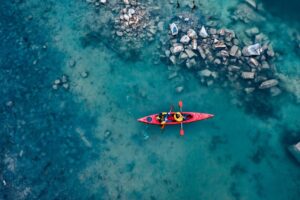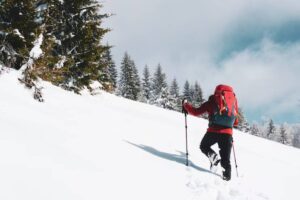The Travel Blog
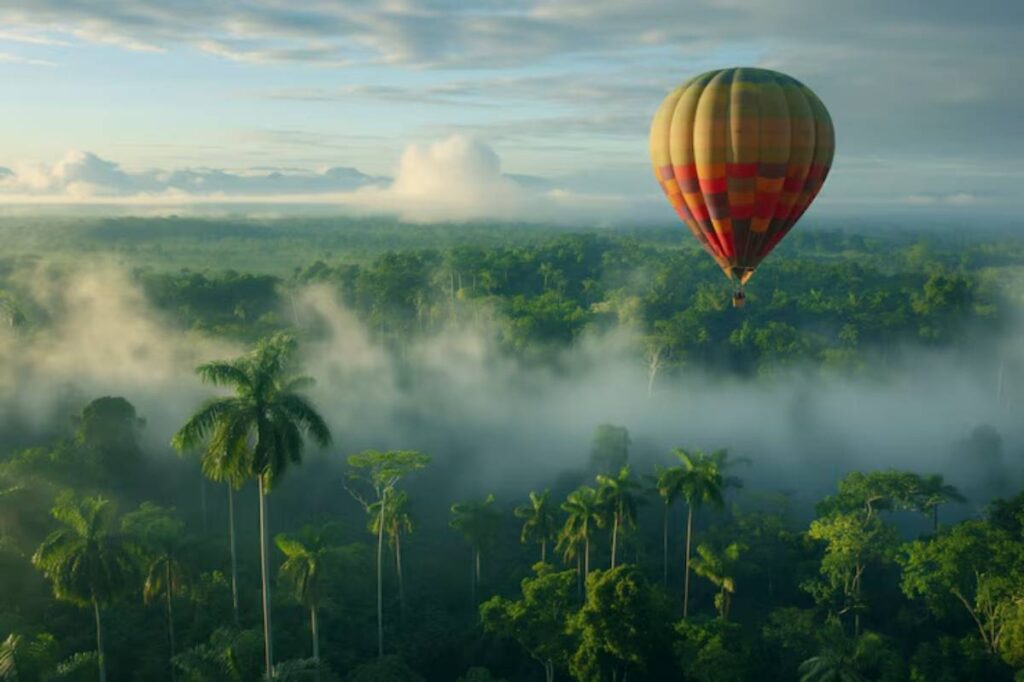
Ballooning Over the Serengeti: Wildlife from the Sky
Where the Skies Tell the Story of the Wild
What if your next safari began not with the rumble of a jeep but the whisper of a flame? Picture yourself floating gently above vast golden plains, the sun rising slowly over the horizon, and below you, elephants, wildebeest, and lions move through the grasses undisturbed. This is the wonder of a hot air balloon safari over the Serengeti — an aerial journey that reveals Africa from a breathtaking new perspective.
In the world of aerial safaris in Tanzania, this experience stands out for its serenity, spectacle, and sheer magic. Whether you’re a seasoned safari-goer or a first-time traveller to Africa, seeing the Serengeti from above transforms your understanding of its beauty, scale, and wildlife rhythms.
In this guide, we’ll take you through everything you need to know — from how to book and what to expect, to real traveller tales, wildlife spotting tips, and ways to make your adventure as meaningful as it is memorable. Let’s ascend.
Why Choose a Hot Air Balloon Safari in the Serengeti?
A Unique Perspective
Ballooning offers a view of the Serengeti that few get to see. From above, you gain a true sense of the park’s vastness, seasonal migration paths, and how different species interact across the terrain.
Silent Flight, Maximum Wildlife
Unlike motorised safaris, hot air balloons glide silently above the herds. The animals remain calm, offering natural behaviour scenes you might miss on the ground.
Golden Hour Magic
Most flights launch at dawn, giving you front-row seats to spectacular sunrises, with light ideal for both photography and wildlife observation.
When to Go: Best Time for Ballooning Over the Serengeti
Dry Season (June to October)
- Best for spotting large animals around rivers and waterholes
- Clear skies and favourable wind conditions
Great Migration Viewing (December to March in the south; July to August in the north)
- Incredible scenes of wildebeest and zebra on the move
- Predators often close behind
Flights are available year-round, but visibility and sightings can vary based on the rain.
What to Expect on Your Balloon Safari
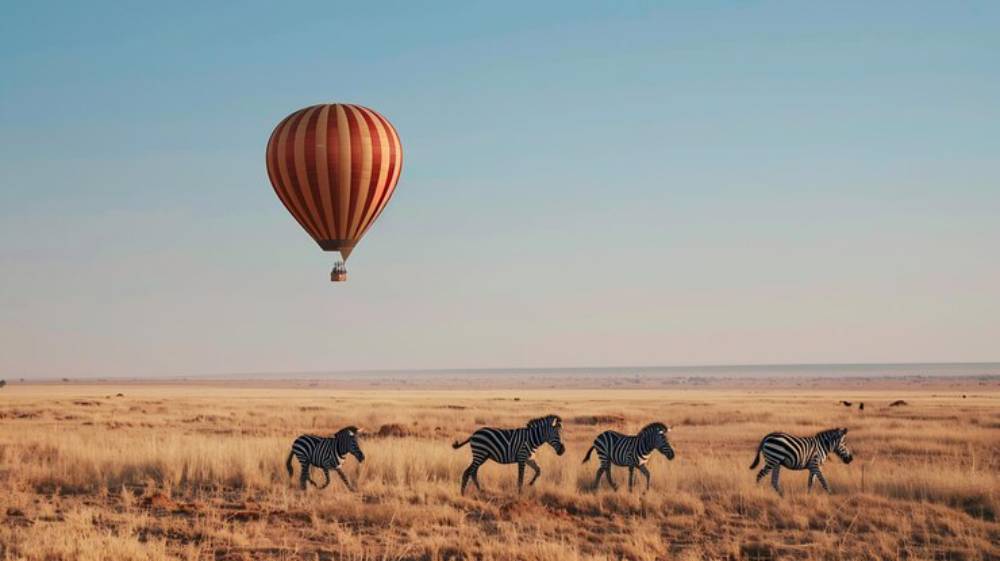
The Early Start
Prepare for a pre-dawn pickup from your lodge or camp. Once you arrive at the launch site, you’ll enjoy a warm drink and a safety briefing.
The Launch
As the burners roar to life and the balloon inflates, anticipation builds. You’ll climb aboard the basket, and before you know it, you’re airborne.
In the Air
- Flights typically last 60 to 90 minutes
- Altitude varies: low glides for animal viewing, higher for panoramic vistas
- Spot elephants, giraffes, hippos, lions, and, if lucky, elusive cheetahs
Landing & Champagne Breakfast
Landings are gentle but unpredictable based on the wind. Afterwards, you’ll be treated to a bush-style breakfast — complete with bubbly!
“Seeing a herd of elephants from above, in complete silence, felt like a dream. The breakfast afterwards was the icing on the cake.” — Olivia, UK
Booking Your Balloon Safari
Where to Start
Many Serengeti lodges offer balloon excursions as add-ons.
Tour operators like:
- Serengeti Balloon Safaris
- Miracle Experience
- Adventures Aloft
All are licensed, safety-regulated, and have experienced pilots.
Costs
Prices range from $500 to $600 USD per person, including transfers, the flight, and breakfast. It’s a premium activity, but one that many describe as worth every cent.
Age & Health Restrictions
- Minimum age: typically 7 years old
- No upper age limit, but you must be able to stand for the duration of the flight
- Not suitable for pregnant travellers or those with serious back/knee issues
What to Wear and Bring
Dress in Layers:
- Mornings can be chilly, especially before sunrise
- Long sleeves and trousers recommended
Footwear:
- Closed, comfortable shoes (trainers or hiking boots)
Accessories:
- Sunglasses and a hat
- Camera or smartphone with a strap
- Binoculars (optional)
Don’t Forget:
- Extra battery or a power bank
- Lightweight backpack
Wildlife You Might See From the Sky
While sightings vary day to day, common animals include:
- Elephants grazing solo or in family groups
- Giraffes moving gracefully across the plains
- Wildebeest and zebras in massive herds during migration
- Lions lounging near kopjes (rocky outcrops)
- Hippos wallowing in muddy pools
If you’re lucky:
- Cheetahs on the hunt
- Rhinos in the distance
- Leopards in trees (harder to spot from above)
For more wildlife-focused adventures, check out Exploring Mount Etna: Sicily’s Active Volcano.
Human Stories: Voices from the Basket
“Our pilot was incredible, pointing out every movement below and sharing stories from years of flights. We saw three lionesses trailing wildebeest!” — Marcus, Germany
“I was nervous at first, but the balloon was so smooth. The silence made it feel like we were floating through time.” — Aisha, Kenya
“My kids were thrilled. It gave them a whole new way to understand the savannah.” — Laura, Australia
Extend Your Serengeti Experience
Why stop at ballooning?
Add:
- A jeep safari for close-up sightings
- A walking safari with a Maasai guide
- A visit to the Ngorongoro Crater nearby
- A cultural tour in local villages
You can also time your trip with the calving season (January to March) for incredible predator-prey interactions.
Travel Tips for a Smooth Journey
- Book flights early, especially during peak migration months
- Consider travel insurance that covers adventure activities
- Bring USD cash for tips and extras
- Support ethical lodges that engage in conservation and local hiring
Responsible Ballooning
- Fly with certified companies only
- Avoid disturbing wildlife or nesting areas
- Take only photos, leave no trace
- Respect park rules and the guides’ advice
Your sky-high journey should uplift nature, not impact it.
Behind the Scenes: What Pilots See
Most balloon pilots in the Serengeti are seasoned experts, often with hundreds or even thousands of hours in the air. Their role isn’t just to fly — they’re storytellers, spotters, and stewards of the sky. Some share stories of spotting rare animals like pangolins or of navigating shifting winds to land just meters from a pod of hippos.
Pilot Quote: “We don’t steer balloons in the traditional sense. We read the wind — like reading a river — and choose the best altitude to catch the flow we want.” — Jean-Paul, Pilot for Miracle Experience
How Ballooning Supports Conservation
Many balloon operators are actively involved in conservation, funding anti-poaching patrols, wildlife monitoring, and local education initiatives through a portion of their tour revenues. By choosing a responsible operator, your flight helps protect the very wilderness you’re floating above.
Ask if your operator is affiliated with the Tanzania Association of Tour Operators (TATO) or contributes to the Serengeti De-snaring Project.
Combining Ballooning with Photographic Safaris
Ballooning offers unique angles that ground safaris can’t match — think zebra herds shaped like brushstrokes across a golden canvas. Some safari packages pair ballooning with guided photo drives, where you’ll receive camera coaching and editing tips.
Hack for Photographers: Use a fast shutter speed (1/500+) for moving animals, and wide-angle lenses (24mm–35mm) for panoramic landscapes.
Cultural Touchpoints: Maasai Traditions and the Sky
Many local ballooning staff come from Maasai communities nearby. You may hear stories of how these nomadic people read animal movements, seasonal changes, and sky patterns — knowledge that beautifully complements your aerial experience.
Add-On Experience: Some balloon safaris offer an optional post-flight visit to a Maasai boma (village), where you can learn about their relationship with the land and wildlife.
The Eco Impact of Ballooning (And How It Compares)
Unlike diesel-run game vehicles, hot air balloons produce relatively low emissions and leave no physical trace. Many companies now use carbon-offset programs and sustainable fuels.
Sustainability Hack: Look for operators who fly with clean-burning propane and practice “leave no trace” landing procedures.
Conclusion: Rise Above the Ordinary
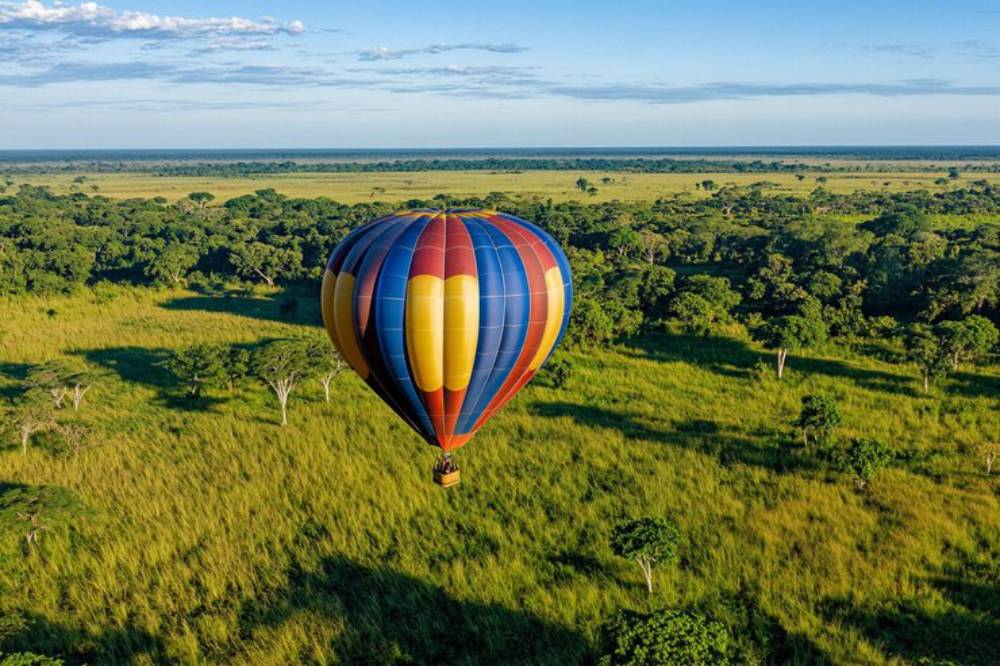
A hot air balloon safari over the Serengeti isn’t just a thrilling ride — it’s a soul-stirring story you’ll carry forever. From the serene lift-off to the golden light cascading across the plains, every second invites you to connect more deeply with Africa’s ancient wilderness.
It’s luxury, it’s adventure, it’s serenity — all wrapped into a single, spectacular morning. Whether you’re chasing the Great Migration or celebrating a life milestone, this flight deserves a place at the top of your travel list.
For a more aerial adventure, go for Hot Air Ballooning in Cappadocia: Soaring Above Fairy Chimneys.
Would you take to the skies above the Serengeti? Drop your thoughts, share your dreams, or ask your burning questions in the comments below.




